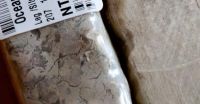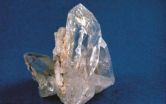(Press-News.org) Bursts of intense global warming that have lasted tens of thousands of years have taken place more frequently throughout history than previously believe, according to evidence gathered by a team led by Scripps Institution of Oceanography, UC San Diego researchers.
Richard Norris, a professor of geology at Scripps who co-authored the report, said that releases of carbon dioxide sequestered in the deep oceans were the most likely trigger of these ancient "hyperthermal" events. Most of the events raised average global temperatures between 2° and 3° Celsius (3.6 and 5.4° F), an amount comparable to current conservative estimates of how much temperatures are expected to rise in coming decades as a consequence of anthropogenic global warming. Most hyperthermals lasted about 40,000 years before temperatures returned to normal.
The study appears in the March 17 issue of the journal Nature.
"These hyperthermals seem not to have been rare events," Norris said, "hence there are lots of ancient examples of global warming on a scale broadly like the expected future warming. We can use these events to examine the impact of global change on marine ecosystems, climate and ocean circulation."
The hyperthermals took place roughly every 400,000 years during a warm period of Earth history that prevailed some 50 million years ago. The strongest of them coincided with an event known as the Paleocene-Eocene Thermal Maximum, the transition between two geologic epochs in which global temperatures rose between 4° and 7° C (7.2° and 12.6° F) and needed 200,000 years to return to historical norms. The events stopped taking place around 40 million years ago, when the planet entered a cooling phase. No warming events of the magnitude of these hyperthermals have been detected in the geological record since then.
Phil Sexton, a former student of Norris' now at the Open University in the United Kingdom, led the analysis of sediment cores collected off the South American coast. In the cores, evidence of the warm periods presented itself in bands of gray sediment layered within otherwise pale greenish mud. The gray sediment contained increased amounts of clay left after the calcareous shells of microscopic organisms were dissolved on the sea floor. These clay-rich intervals are consistent with ocean acidification episodes that would have been triggered by large-scale releases of carbon dioxide. Large influxes of carbon dioxide change the chemistry of seawater by producing greater amounts of carbonic acid in the oceans.
The authors concluded that a release of carbon dioxide from the deep oceans was a more likely cause of the hyperthermals than other triggering events that have been hypothesized. The regularity of the hyperthermals and relatively warm ocean temperatures of the period makes them less likely to have been caused by events such as large melt-offs of methane hydrates, terrestrial burning of peat or even proposed cometary impacts. The hyperthermals could have been set in motion by a build-up of carbon dioxide in the deep oceans caused by slowing or stopping of circulation in ocean basins that prevented carbon dioxide release.
Norris noted that the hyperthermals provide historical perspective on what Earth will experience as it continues to warm from widespread use of fossil fuels, which has increased carbon dioxide concentrations in the atmosphere nearly 50 percent since the beginning of the Industrial Revolution. Hyperthermals can help scientists produce a range of estimates for how long it will take for temperatures to fully revert to historical norms depending on how much warming human activities cause.
"In 100 to 300 years, we could produce a signal on Earth that takes tens of thousands of years to equilibrate, judging from the geologic record," he said.
The scientists hope to better understand how fast the conditions that set off hyperthermals developed. Norris said that 50 million year old sediments in the North Sea are finely layered enough for scientists to distinguish decade-to-decade or even year-to-year changes.
INFORMATION:
Co-authors of the paper include researchers from the National Oceanography Centre Southampton at the University of Southampton in England and the Center for Marine Environmental Sciences, University of Bremen, Germany.
Scripps Institution of Oceanography: scripps.ucsd.edu
Scripps News: scrippsnews.ucsd.edu
About Scripps Institution of Oceanography
Scripps Institution of Oceanography at University of California, San Diego, is one of the oldest, largest and most important centers for global science research and education in the world. Now in its second century of discovery, the scientific scope of the institution has grown to include biological, physical, chemical, geological, geophysical and atmospheric studies of the earth as a system. Hundreds of research programs covering a wide range of scientific areas are under way today in 65 countries. The institution has a staff of about 1,400, and annual expenditures of approximately $170 million from federal, state and private sources. Scripps operates robotic networks, and one of the largest U.S. academic fleets with four oceanographic research ships and one research platform for worldwide exploration. Learn more at scripps.ucsd.edu.
About UC San Diego
Fifty years ago, the founders of the University of California, San Diego, had one criterion for the campus: It must be distinctive. Since then, UC San Diego has achieved the extraordinary in education, research and innovation. Sixteen Nobel laureates have taught on campus; stellar faculty members have been awarded Fields Medals, Pulitzer Prizes, McArthur Fellowships and many other honors. UC San Diego—recognized as one of the top ten public universities by U.S. News & World Report and named by the Washington Monthly as number one in the nation in rankings measuring "what colleges are doing for the country"—is widely acknowledged for its local impact, national influence and global reach. UC San Diego is celebrating 50 years of visionaries, innovators and overachievers. www.50th.ucsd.edu
Ancient 'hyperthermals' a guide to anticipated climate changes
Scripps researchers document the history of sudden global warming events, impacts on marine life
2011-03-18
ELSE PRESS RELEASES FROM THIS DATE:
Standards education vital for global business needs, says Asia-Pacific Economic Group
2011-03-18
In just a few months, millions of young adults will graduate from college and step into productive careers in the global economy. Meanwhile, those already involved in standardization, particularly in the engineering and technology sectors, and increasingly those with policy, legal, and business backgrounds, are working in a new environment where standards play a crucial role in international trade and competitiveness. But according to the attendees of a meeting of the Asia-Pacific Economic Cooperation (APEC) Subcommittee on Standards and Conformance, comparatively few new ...
The RV Chef is Now Online!
2011-03-18
When you pull off the highway and head into your favorite campground, don't forget to tune in the latest Internet program - The RV Chef.
RV Chef is produced for RVers to show that food on the road does not have to be fast or mediocre. With some planning and preparation, wonderful meals are no further away than the picnic table.
As the producer and chef, George Murphy has gained a lot of experience in the 25 years he's been RVing. "We hope to produce one program every week or so that will run from 5 - 8 minutes and each and will show the viewer how to make wonderful ...
High-tech concrete technology has a famous past
2011-03-18
In the business of concrete making, what's old—even ancient—is new again.
Almost 1,900 years ago, the Romans built what continues to be the world's largest unreinforced solid concrete dome in the world—the Pantheon. The secret, probably unknown to the Emperor Hadrian's engineers at the time, was that the lightweight concrete used to build the dome had set and hardened from the inside out. This internal curing process enhanced the material's strength, durability, resistance to cracking, and other properties so that the Pantheon continues to be used for special events to ...
Viscous cycle: Quartz is key to plate tectonics
2011-03-18
More than 40 years ago, pioneering tectonic geophysicist J. Tuzo Wilson published a paper in the journal Nature describing how ocean basins opened and closed along North America's eastern seaboard.
His observations, dubbed "The Wilson Tectonic Cycle," suggested the process occurred many times during Earth's long history, most recently causing the giant supercontinent Pangaea to split into today's seven continents.
Wilson's ideas were central to the so-called Plate Tectonic Revolution, the foundation of contemporary theories for processes underlying mountain-building ...
NIST releases final report on Charleston sofa store fire
2011-03-18
The National Institute of Standards and Technology (NIST) has released its final report on its study of the June 18, 2007, fire at the Sofa Super Store in Charleston, S.C., that trapped and killed nine firefighters, the highest number of firefighter deaths in a single event since 9/11. The final report is strengthened by clarifications and supplemental text based on comments provided by organizations and individuals in response to the draft report of the study, released for public comment on Oct. 28, 2010.
The revisions did not alter the study team's main finding: the ...
Pig model of cystic fibrosis improves understanding of disease
2011-03-18
It's been more than 20 years since scientists first discovered the gene that causes cystic fibrosis (CF), yet questions about how the mutated gene causes disease remain unanswered.
Using a newly created pig model that genetically replicates the most common form of cystic fibrosis, University of Iowa researchers have now shown that the CF protein is "misprocessed" in the pigs and does not end up in the correct cellular location. This glitch leads to disease symptoms, including gastrointestinal abnormalities and lung disease in the pigs, which mimic CF in humans. The findings ...
Online messaging delivers follow-up care for depression
2011-03-18
SEATTLE—Online messaging can deliver organized follow-up care for depression effectively and efficiently, according to a randomized controlled trial of 208 Group Health patients that the Journal of General Internal Medicine e-published in advance of print.
After five months, compared to the half of the patients randomly assigned to receive usual care, the half who had three online care management contacts with a trained psychiatric nurse were significantly more likely to feel less depressed, take their antidepressant medication as prescribed, and be "very satisfied" ...
Book Marketing: 3 Ways To Tell If You Have a Good Book Promotion Strategy by Annie Jennings PR
2011-03-18
By national publicity expert, Annie Jennings, of the famous PR firm, Annie Jennings PR
Authors are flocking to print on demand publishing and other non-traditional methods of publishing their book. With this growth of authors hitting the scene, so do a myriad of ways to promote a book. With so many choices available to them, how do author choose the right book marketing and book promotion strategy for them.
National publicity expert, Annie Jennings PR, whose national PR firm has worked with thousands of book authors, shares 3 ways to tell if you like your book marketing ...
WHOI-led report links sonar to whale strandings
2011-03-18
Scientists have long been aware of a link between naval sonar exercises and unusual mass strandings of beaked whales. Evidence of such a link triggered a series of lawsuits in which environmental groups sued the U.S. Navy to limit sonar exercises to reduce risk to whales. In 2008, this conflict rose to the level of the US Supreme Court which had to balance potential threat to whales from sonar against the military risk posed by naval forces inadequately trained to use sonar to detect enemy submarines. The court ruled that the Navy could continue training, but that it was ...
2 new SCAP documents help improve automating computer security management
2011-03-18
It's increasingly difficult to keep up with all the vulnerabilities present in today's highly complex operating systems and applications. Attackers constantly search for and exploit these vulnerabilities to commit identity fraud, intellectual property theft and other attacks. The National Institute of Standards and Technology (NIST) has released two updated publications that help organizations to find and manage vulnerabilities more effectively, by standardizing the way vulnerabilities are identified, prioritized and reported.
Computer security departments work behind ...
LAST 30 PRESS RELEASES:
Why nail-biting, procrastination and other self-sabotaging behaviors are rooted in survival instincts
Regional variations in mechanical properties of porcine leptomeninges
Artificial empathy in therapy and healthcare: advancements in interpersonal interaction technologies
Why some brains switch gears more efficiently than others
UVA’s Jundong Li wins ICDM’S 2025 Tao Li Award for data mining, machine learning
UVA’s low-power, high-performance computer power player Mircea Stan earns National Academy of Inventors fellowship
Not playing by the rules: USU researcher explores filamentous algae dynamics in rivers
Do our body clocks influence our risk of dementia?
Anthropologists offer new evidence of bipedalism in long-debated fossil discovery
Safer receipt paper from wood
Dosage-sensitive genes suggest no whole-genome duplications in ancestral angiosperm
First ancient human herpesvirus genomes document their deep history with humans
Why Some Bacteria Survive Antibiotics and How to Stop Them - New study reveals that bacteria can survive antibiotic treatment through two fundamentally different “shutdown modes”
UCLA study links scar healing to dangerous placenta condition
CHANGE-seq-BE finds off-target changes in the genome from base editors
The Journal of Nuclear Medicine Ahead-of-Print Tip Sheet: January 2, 2026
Delayed or absent first dose of measles, mumps, and rubella vaccination
Trends in US preterm birth rates by household income and race and ethnicity
Study identifies potential biomarker linked to progression and brain inflammation in multiple sclerosis
Many mothers in Norway do not show up for postnatal check-ups
Researchers want to find out why quick clay is so unstable
Superradiant spins show teamwork at the quantum scale
Cleveland Clinic Research links tumor bacteria to immunotherapy resistance in head and neck cancer
First Editorial of 2026: Resisting AI slop
Joint ground- and space-based observations reveal Saturn-mass rogue planet
Inheritable genetic variant offers protection against blood cancer risk and progression
Pigs settled Pacific islands alongside early human voyagers
A Coral reef’s daily pulse reshapes microbes in surrounding waters
EAST Tokamak experiments exceed plasma density limit, offering new approach to fusion ignition
Groundbreaking discovery reveals Africa’s oldest cremation pyre and complex ritual practices
[Press-News.org] Ancient 'hyperthermals' a guide to anticipated climate changesScripps researchers document the history of sudden global warming events, impacts on marine life






